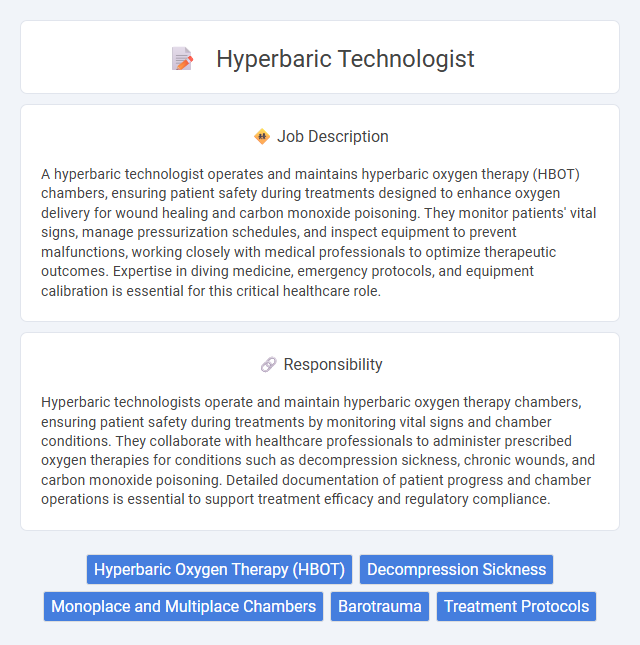
A hyperbaric technologist operates and maintains hyperbaric oxygen therapy (HBOT) chambers, ensuring patient safety during treatments designed to enhance oxygen delivery for wound healing and carbon monoxide poisoning. They monitor patients' vital signs, manage pressurization schedules, and inspect equipment to prevent malfunctions, working closely with medical professionals to optimize therapeutic outcomes. Expertise in diving medicine, emergency protocols, and equipment calibration is essential for this critical healthcare role.
Individuals with a strong interest in hyperbaric medicine and a background in healthcare or technical fields will likely find the hyperbaric technologist job suitable. Those who are comfortable working in pressurized environments and managing patient care under specific oxygen therapy protocols may adapt well to the responsibilities. However, people with claustrophobia or difficulty following strict safety procedures might find this occupation challenging.
Qualification
A Hyperbaric Technologist typically requires certification in hyperbaric medicine technology or a related healthcare field, often including credentials from recognized bodies such as the National Board of Diving and Hyperbaric Medical Technology (NBDHMT). Essential qualifications include knowledge of hyperbaric oxygen therapy protocols, patient monitoring, and emergency procedures within hyperbaric chambers. Clinical experience in wound care, respiratory therapy, or critical care nursing enhances a candidate's competency in operating hyperbaric equipment safely and effectively.
Responsibility
Hyperbaric technologists operate and maintain hyperbaric oxygen therapy chambers, ensuring patient safety during treatments by monitoring vital signs and chamber conditions. They collaborate with healthcare professionals to administer prescribed oxygen therapies for conditions such as decompression sickness, chronic wounds, and carbon monoxide poisoning. Detailed documentation of patient progress and chamber operations is essential to support treatment efficacy and regulatory compliance.
Benefit
Hyperbaric technologists likely experience benefits such as improved professional skills in administering oxygen therapy under increased atmospheric pressure. The role probably offers exposure to innovative medical technologies and collaboration with healthcare teams, enhancing career development. There may also be potential for job stability and competitive compensation due to the specialized nature of the work.
Challenge
A hyperbaric technologist position likely involves complex challenges related to ensuring patient safety during hyperbaric oxygen therapy sessions. Managing precise equipment settings while closely monitoring patients' physiological responses probably requires strong technical expertise and attention to detail. The role may also demand quick decision-making skills to address unexpected complications in a high-pressure environment.
Career Advancement
A Hyperbaric Technologist advances by gaining specialized certifications such as Certified Hyperbaric Registered Technologist (CHRT) and extensive clinical experience in hyperbaric oxygen therapy units. Career growth opportunities include progressing to supervisory roles, clinical coordinators, or transitioning into related fields like wound care management and hyperbaric medicine research. Continuous education and training in emerging hyperbaric technologies and protocols significantly enhance professional development and earning potential.
Key Terms
Hyperbaric Oxygen Therapy (HBOT)
Hyperbaric technologists specialize in administering Hyperbaric Oxygen Therapy (HBOT), a medical treatment that involves breathing 100% oxygen in a pressurized chamber to enhance oxygen delivery to tissues. They are responsible for monitoring patient responses, operating hyperbaric chambers, and ensuring safety protocols to prevent complications such as oxygen toxicity or barotrauma. Expertise in HBOT is critical for treating conditions like carbon monoxide poisoning, non-healing wounds, and decompression sickness.
Decompression Sickness
A Hyperbaric Technologist specializes in operating hyperbaric oxygen therapy (HBOT) equipment to treat Decompression Sickness (DCS), a condition caused by rapid pressure changes that result in nitrogen bubble formation in tissues. They monitor patient oxygen levels, control chamber pressure, and ensure safety protocols to effectively reduce symptoms such as joint pain, dizziness, and paralysis. Expertise in DCS pathophysiology and hyperbaric treatment protocols is essential for optimizing patient outcomes and preventing bubble-induced tissue damage.
Monoplace and Multiplace Chambers
Hyperbaric technologists specialize in operating Monoplace and Multiplace chambers, ensuring patient safety and effective treatment during hyperbaric oxygen therapy sessions. Expertise involves maintaining chamber functionality, monitoring physiological responses, and managing emergency protocols specific to pressurized environments. Proficiency in technical operations and regulatory compliance is crucial for optimizing therapeutic outcomes in clinical hyperbaric settings.
Barotrauma
Hyperbaric technologists specialize in operating hyperbaric oxygen therapy chambers used to treat barotrauma, a condition caused by pressure changes damaging body tissues, particularly the ears, sinuses, and lungs. They monitor patients closely during treatments to prevent and manage barotrauma symptoms, ensuring safe pressurization and decompression protocols. Expertise in understanding pressure-related injuries and oxygen toxicity risks is essential for optimizing patient outcomes in hyperbaric medicine.
Treatment Protocols
Hyperbaric technologists specialize in administering hyperbaric oxygen therapy (HBOT) by following precise treatment protocols tailored to various medical conditions such as decompression sickness, carbon monoxide poisoning, and chronic wound healing. These protocols involve controlled pressurization cycles and specific oxygen delivery durations to maximize therapeutic outcomes while ensuring patient safety. Adherence to established guidelines, including monitoring vital signs and managing potential side effects, is critical for effective and safe hyperbaric treatment administration.
 kuljobs.com
kuljobs.com